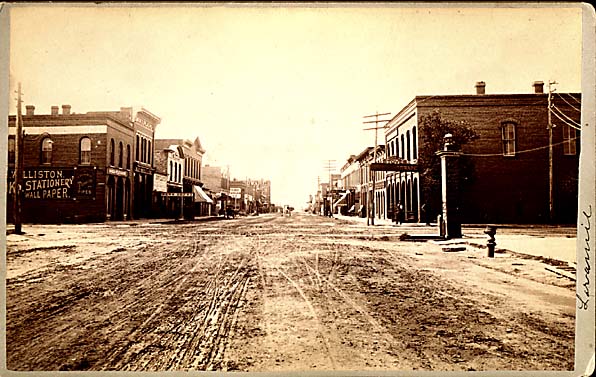
Second Street looking south from Thornburg (now Ivinson Ave.), 1890's.
Compare above scene with Second Street from 1907. On the left is W. H. Williston's Stationery and
Book Store. The second building is Simon Durlacher's "Star Clothiers." The Simon Durlacher Building is still in existence.
The third building housed the Still Bros. Bakery. The first building on the right is the
A. E. Miller's "Temple of Economy." In 1899, as indicated in the next photo, the building was replaced with the "Miller Block." In the distance may be seen
the
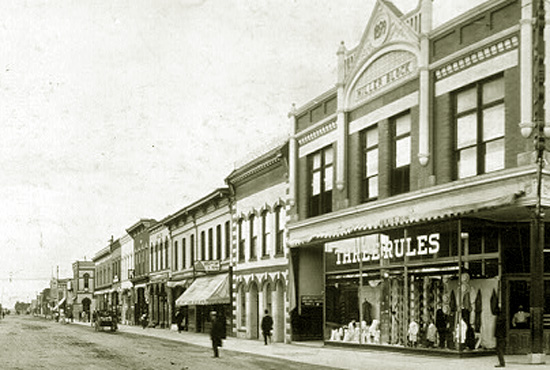
West side Second Street looking south, 1907.
The first building is the Miller Block. The pediment bears the date, "1899" "Miller Block". The pediment has been changed to
read "Midwest Block." The building originally housed
A. E. Miller's "Temple of Economy," a department store. In 1904, Miller, then mayor of Laramie, sold the store to
the owners of the Three Rules stores from Denver, a chain of about eleven clothing stores in the
Rocky Mountain West. Later the store still going under the name Three Rules was owned by Gish-Hunter Mercantile Co.
From about 1911 to about 1922,
Gish-Hunter was a heavy advertiser in the Boomerang, the Republican, and the
Wyoming Student. Every advertisment featured the words "Three Rules." No place in the advertisements were there any hints
as to what the "Three Rules" were. It was like the expression attributed to
W. Somerset Maugham,"There are three rules for writing the novel. Unfortunately, no one knows what they are."
About 1922, the building was sold to Charles L. Clark, a jeweler, music and Victrola dealer.
Upstairs over the Three Rules store were professional offices for dentists, physicians, and lawyers. One lawyer, George W. Patterson, had the misfortune
to have a client shot and killed outside his door. Gladys Bergstrom, who had been married for only
about three months to Roy E. Bergstrom, came to Patterson to consult about a divorce. Outside the
door, her husband ended the need for a divorce by pumping three bullets into her. Bergstrom was charged and convicted of
first degree murder and sentenced to life at Rawlins. By 1922, Bergstom was refusing to get out of his bunk where he laughed
uncontrolably. The laughter turned to sobbing. He was found insane and sent to Evanston.
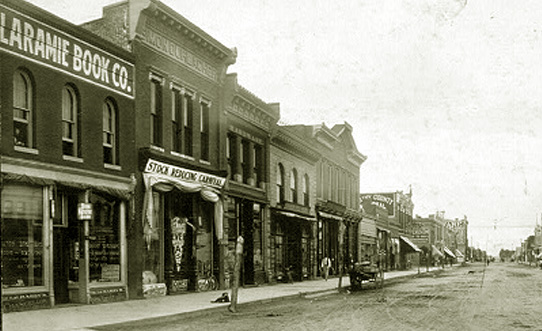
East side Second Street looking south, 1907.
As indicated in the next photo, the book store later housed a grocery. The building was later replaced with
the First State Bank Building. The Simon Durlacher Building was constructed in the 1870's and expanded in 1890. Durlacher ((1837-1893) arrived in
Laramie in 1868 and was employed in B. Hellman's clothing store until he opened his own
store in 1873. Thereafter, in the Daily Boomerang Durlacher's and Hellman's advertisements appeared adjacent to each other. Durlacher claimed that his was
"the Pioneer Clothing House of Laramie" and Hellman pointly publishing the date his store was established.
Durlacher was born in Baden in what is now Germany and came to Pennsylvania. During the Civil War he served in the 6th
Pennsylaania Reserves in the defense of Washington. He was a member of both the Masons and the
Grand Army of the Republic.
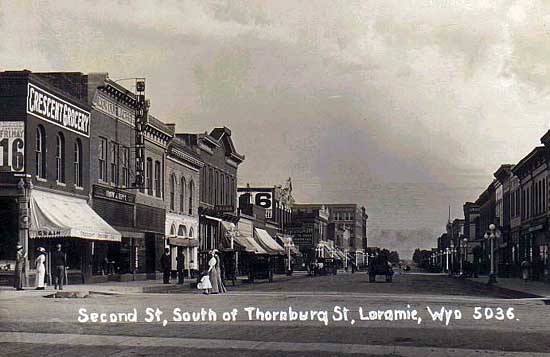
Second Street looking south, 1913. Photo by H. Svenson.
In the distance is the W. H. Holliday Co. building at Second and Garfield, the largest building in Laramie at the time. In addition to
housing the Holliday store discussed on a later page, it housed professional offices. The third building housed a bakery. Further down the street,
is Frank Eggleston's Drug Store, later replaced by Cordiner's. Both Eggleston's and
Cordiner's featured a soda fountain. In popular imagery, western streets were lined with saloons. In actuality, soda fountains were more
popular. Indeed, by 1880 Otto Gramm featured a soda fountain in his Laramie drug store. On a three block stretch of South Second Street there were at
lease five soda fountains: the Brunswick Billiard Parlor at 314 South 2nd Street, Lester's Drug Store at 303 South Second Street, The Eggleston Drug Co., the Brandis Confectinary Store, and the Laramie Drug Company.
The latter had not one but two soda jerks dishing up the concoctions. The Brunswick advertised that it
was a member of the "National Billiard Protective Association for the Surpression of Gambling and Rowdyism and Profanity." Other soda fountains were found in the "Smoke House," Taylor's Drug Co.,
the Central Drug Co. the Mills Book Store, and the Wyoming Pool Hall. All popular businesses
seem to attract the attention of the government as another source of revenue. Indeed, in a front page story, the
Boomerang reported on April 13, 1906, that the Internal Revenue was cracking down on soda fountains. The story, under the headline,
"PHOSPHATES UNDER THE BAN,' indicated that a
ruling by the Internal Revenue Commissioner would affect soda fountains at the Union Pacific Store and Dr. Hammond's drug store
in Hanna and the drug store in Medicine Bow. The article continued by speculating that the ruling could affect all of the
local candy stores, some grocery stores, billiard parlors, etc. throughout the state. It was not expected to
adversly affect the soda fountains in Laramie as they were already licensed by Internal Revenue.
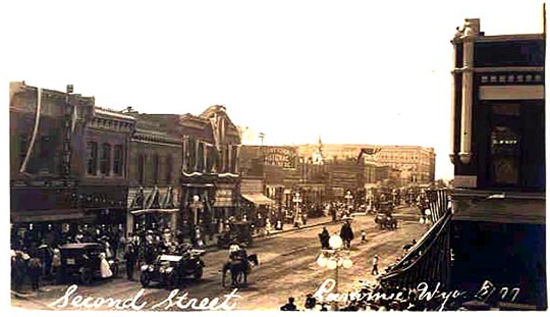
East side Second Street, looking south, approx. 1913. Photo by H. Sevnson.
From the 1880’s through the early 1960’s soda fountains were ubiquitous American fixtures.
Indeed, the Saturday Evening Post featured soda fountains on its front cover at least
three times. The first in 1912 with the cover by famed American magazine and book
illustrator Clarence F. Underwood, followed by an illustration by Frances Tipton Hunter in 1936, and one by Norman Rockwell in 1953.
At one time, soda fountains were a fixture at the various drug stores. Later five and ten cent stores such as Woolworth’s located on second street had “luncheonettes” at which ice cream sodas and
real milkshakes were served along with club sandwiches with potato salad and other light lunches. All are now gone.
The soda fountains across the nation were all similar. The older counters were made of marble,
the newer were made of Formica with stainless steel trim.
In front were stools on a stainless steel pedestal with a footrest on the front. The seat was typically upholstered in Naugahyde and could endlessly spin around. A delight for small children. The writer often wondered what type of animal a “nauga” was. The material was actually named for a town in Connecticut where it was manufactured.
Behind the counter were various dispensers for flavored syrups, and an ice cream cabinet. Behind the back bar, typically made of stainless steel, was usually a mirror in front of which would repose the glassware.
In later years, on the back bar would also be one or two Hamilton-Beach milk shake machines made of stainless
steel. The fountain would have several soda taps as well as containers for cherries,
strawberries, crushed pineapple and Borden’s or Harlick’s malted milk — necessary for
creation of sundaes, banana splits and malteds. Walgreen soda fountains featured malteds
made with Harlick’s.The lord and master of the soda fountain was the soda jerk, a profession which has now also disappeared. He often wore a paper hat, white shirt and black bow tie.
At the soda fountain, one could order a phosphate, or a lime ricky, or other drinks.
The phosphate basically was seltzer water from the soda water tap mixed with fruit syrup. The
lime ricky was lime juice with the seltzer water. When soda fountains were at their height of
popularity, there were no pre-mixes as today. Thus, making a proper phosphate or soda was an art, requiring dexterity to avoid to little
syrup and avoiding overuse of the carbon dioxide gas which was expensive.
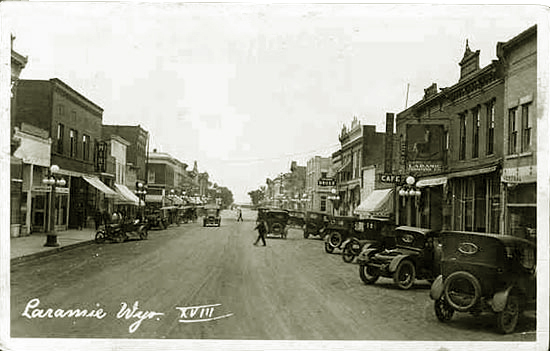
Second Street, approx. 1918. Photo by Henning Svenson.
The "Mint" on the left hand side of the street in the McCue Building was a billiard hall. Upstairs was the law office of
Cassius M. Eby (1862-1942). Eby arrived in Laramie in 1910 after a contentious divorce proceeding in Boulder, Colorado,
in which his wife was
ultimately adjudged insane and committed to the work assylum. Eby previously practiced law in Boulder and
Cassopolis, Michigan. He was a Mason, a member of the Sons of the American Revolution, and served a term
as President of the Albany County Bar Association. To a great extent, he represented the typical lawyer of the
early Twentieth Century, the type of attorney who had an office on the second floor of some commercial building with a sign
painted on the office window; a sole practicioner who handled just about any type of case. In Michigan he served as a
prosecuting attorney, but in private practice he also defended criminal cases. In Wyoming, he handled various types of
criminal cases, personal injury cases, irrigation cases and well as property quiet title actions and probate..
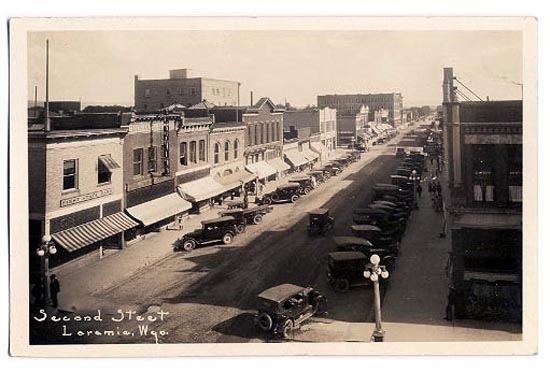
East Side of Second Street looking south, approximately 1924. Photo by H. Svenson
The tall building in the distance on the left of the photo is the Wagner Building at 209 Grand Avenue. The building housed offices on the first four floors and
apartments on the fifth floor.
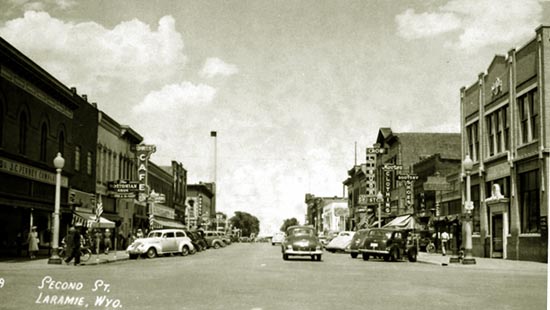
Second Street, looking north, approx. 1941.
On the left, is the J. C. Penney Co. It later moved to Grand Avenue.
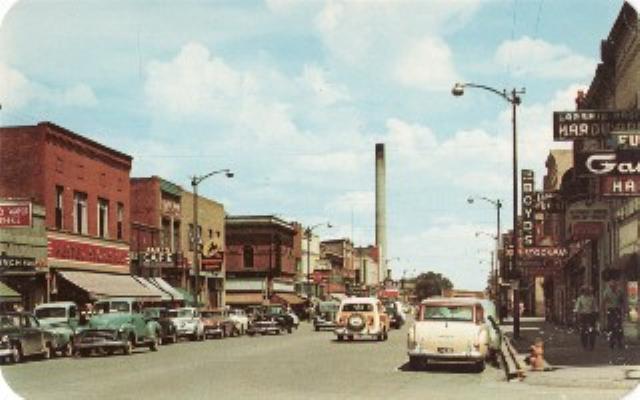
Second Street, looking north, approx. 1952.
Note the change in the street lamps.
Next Page: Laramie Continued, The Fox Theatre.
|